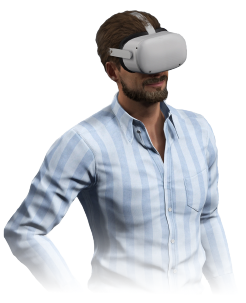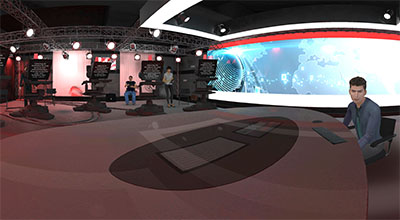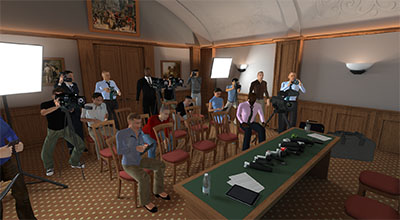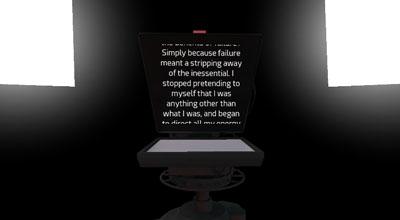Media Training

Course Outcomes
- Learn how to deliver important messages that are memorable and tell a story
- Ability to put yourself forward as a spokesperson for your organization
- Training in the principles of media communication and exposure to the media
- Learn to adapt your message depending on the type of interview
- Effectively deal with journalists with practice in a range of exercises

Practice engaging with the media
Effectively engaging the media has never been more important. Brands, organizations, and business leaders are under extraordinary pressure to rapidly and transparently communicate what they are doing and why.
Every time you talk to a journalist, you have an opportunity to protect and enhance your reputation. The right training and preparation can help you make the most of that opportunity.
In this course, you'll practice different situations in online exercises or immersive virtual reality (if you have a VR headset), where you'll be able to test out new approaches and learn to communicate with poise, clarity, and conviction.
Who should take this course?
This course is aimed at people who may or will have to deal with the media as part of their job role, for example, senior managers, startup founders, or company spokespeople.
The course has a slight focus on crisis communications, however, there are also practice questions on the following topics:
Online learning, done differently

Learn online, anytime

Practice with exercises
Build your skills and confidence by putting them to the test with computer-generated audiences and AI-generated questions.

Improve with feedback
Receive instant feedback on your performance to help identify your strengths and weaknesses.
Media Training: Topics you can practice
1. Understanding how to adapt your message depending on the type of interview
2. Defending an organization or political position on camera
3. Putting yourself forward as a media spokesperson for your organization
4. Presentation and debating skills necessary for a challenging interview
5. Literary techniques you can use to explain your message
6. Delivery of important messages that are memorable and tell a story
7. Preparing you for all eventualities, from breakfast TV to live questioning in a crisis
8. Nonverbal techniques, including eye contact and body language
9. Building your confidence through realistic practice in our virtual reality scenarios

Practice exercises
Practice talking with journalists and dealing with the media in a variety of common situations. After each practice session, you'll receive feedback on your performance.

BBC-styled studio interview
Practice answering interview questions in a BBC-styled studio. Be more prepared for an upcoming TV interview and learn what to say when under pressure.

Press conference training
Read your uploaded pre-prepared statement at a press conference event, before answering questions from journalists.

Down-the-line interview
Practice reading a transcript at different speeds, with just a camera in the room with you. Focus on your tone and body language when speaking to camera.

Radio or podcast interview
In this scenario, you'll be interviewed for a radio show or podcast and understand how what you say and behave differs from being in front of a camera.

Media ambush
Experience being ambushed by the media in a hotel lobby and practice answering hostile questions.
Features in the practice exercises
What's included in this course:
- 6 practice exercises
- All practice features
- Flexible, self-led format
- Quizzes and assessment
- Earn a digital course certificate
- Access to updated content
Access all courses
US $45
(per month)
All training in the course catalogue
Frequently Asked Questions
You can access the classes through the VirtualSpeech website, on any standard web browser such as Chrome, Firefox, or Safari.
The practice exercises can be completed online or in virtual reality (if you have a VR headset).
When you enroll in the course, you'll get 24/7 access to the course (including tutorial videos, case studies, practice exercises, VR, and more) through the VirtualSpeech website and in VR.
Both the online classes and exercises run in your browser, no additional software or download is required.
If you have a VR headset, you can also access the practice exercises in VR. Here's a list of our recommended VR headsets.
The online exercises have been tested across multiple browsers and run smoothly on Google Chrome, Safari, Firefox, Internet Explorer, and Edge.
We accept payment via Credit Card, Debit Card or PayPal directly through the VirtualSpeech site. If you'd like to pay with an Invoice or using another payment method, please contact us.
Yes you can. After pressing the 'Buy Now' button on this page, select the number of users (maximum is 25).
After the payment, you'll be made course admin and can add users to the course from the admin dashboard.
Yes, when you've completed this course, we'll send you a Certificate of Achievement, which you can share in the Certifications section of your LinkedIn profile, on printed resumes, CVs, or other documents.
If the course does not meet your expectations, you can get a full refund within 7 days of purchasing the course.